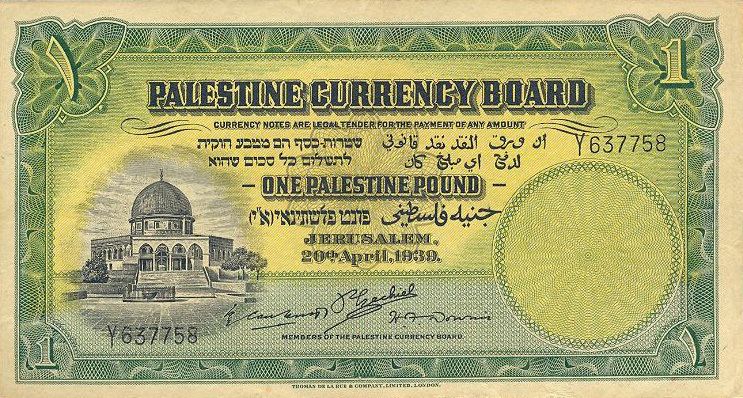1/1000 Mill | ||
 | ||
Banknotes 500 mils, 1, 5, 10, 50, 100 pounds Coins 1, 2, 5, 10, 20, 50, 100 mils Central bank Palestine currency Board | ||
The Palestine pound (Arabic: جُنَيْه فِلَسْطَينِيّ, junyah filastini; Hebrew: פֿוּנְט פַּלֶשְׂתִינָאִי א"י)), funt palestina'i (eretz-yisra'eli), also Hebrew: לירה א"י)) lira eretz-yisra'elit) was the currency of the British Mandate of Palestine from 1927 to May 14, 1948, and of the State of Israel between May 15, 1948, and August 1952, when it was replaced with the Israeli lira. It was divided into 1000 mils (Arabic: Arabic: مِل, Hebrew: Hebrew: מִיל). The Palestine pound was also the currency of Transjordan until 1949 and remained in usage in the West Bank Governorate of Jordan until 1950.
Contents
History
Until 1918, Ottoman Levant was an integral part of the Ottoman Empire and therefore used its currency, the Ottoman lira. Following the institution of the British Mandate for Palestine, the Egyptian pound also circulated alongside the Ottoman lira until 1927. This created an unsatisfactory situation which required a currency reform. The Palestine pound was introduced by the British, equal in value to the pound sterling.
Unlike the pound sterling in the United Kingdom, and the sterling-equivalent Cypriot pound in British-run Cyprus, the Palestine pound was from its introduction a decimal currency, albeit with each pound divided into one thousand parts, called mils. This system was derived from a proposal made in 1855, by William Brown, a member of the United Kingdom parliament, that the United Kingdom pound should be decimalised by being divided into one-thousand parts, each called a mil. Although this system was never adopted in the United Kingdom, it was used by the British colonial authorities first in Hong Kong from 1863 to 1866, and then in the British Palestine Mandate from 1926 until 1948. It was also adopted in Cyprus in 1955, where the Palestinian pound had briefly been introduced as legal tender, following a currency shortage in 1943.
The Palestine pound was also declared a legal tender in the Transjordan Emirate, which was technically a part of the British Mandate, though having an autonomous local administration. The body which governed the issue of the currency was the Palestine Currency Board, which was subject to the British Colonial Office. The Currency Board was dissolved in May 1948, as the British Mandate ended. The area in which the Palestine pound circulated was divided into several political entities: the State of Israel, the Hashemite Kingdom of Transjordan, the Jordanian-occupied West Bank and the Egyptian-occupied Gaza Strip.
In Israel, there was a transitional period of four years between the end of the British Mandate and the adoption of a fully independent currency system. Between 1948 and 1952, the Palestine pound continued to be a legal tender. In August 1948, new banknotes were issued by the Anglo Palestine Company, owned by the Jewish Agency and based in London.
In Jordan, the Palestine pound was replaced by the Jordanian dinar in 1949. In 1950, Jordan annexed the West Bank, and the Palestine pound continued to circulate there until 1950. The Jordanian dinar is still legal tender in the West Bank along with the Israeli shekel.
In the Gaza Strip, the Palestine pound circulated until April 1951, when it was replaced by the Egyptian pound, three years after the Egyptian army took control of the All-Palestine Protectorate. Today, Gaza Strip inhabitants mostly use the Israeli shekel.
In the Oslo Accords, the Palestinian Authority was debarred from issuing its own currency and constrained to remain dependent on the Israeli or Jordanian currencies. However, the Palestinians were able to issue postage stamps and these were valued in terms of the Palestine pound, which Palestinian economists and officials declared to be a still-existent (though at present "dormant") currency, to be revived after Palestinian independence. In practice, prices in the Palestinian territories are quoted in Israeli currency.
There was a report that the Palestinian authorities were considering issuing new banknotes and coins in 2011. This, however, never came to fruition.
Coins
In 1927, coins were introduced in denominations of 1, 2, 5, 10, 20, 50 and 100 mils. The 1 and 2 mils were struck in bronze, whilst the 5, 10 and 20 mils were holed, cupro-nickel coins, except for during World War II, when they were also minted in bronze. The 50 and 100 mils coins were struck in .720 silver.
All the denominations were trilingual in Arabic, English and Hebrew. The Hebrew inscription includes the initials Alef Yud after "Palestina", for "Eretz Yisrael" (Land of Israel). The last coins were issued for circulation in 1946, with all 1947 dated coins being melted down.
